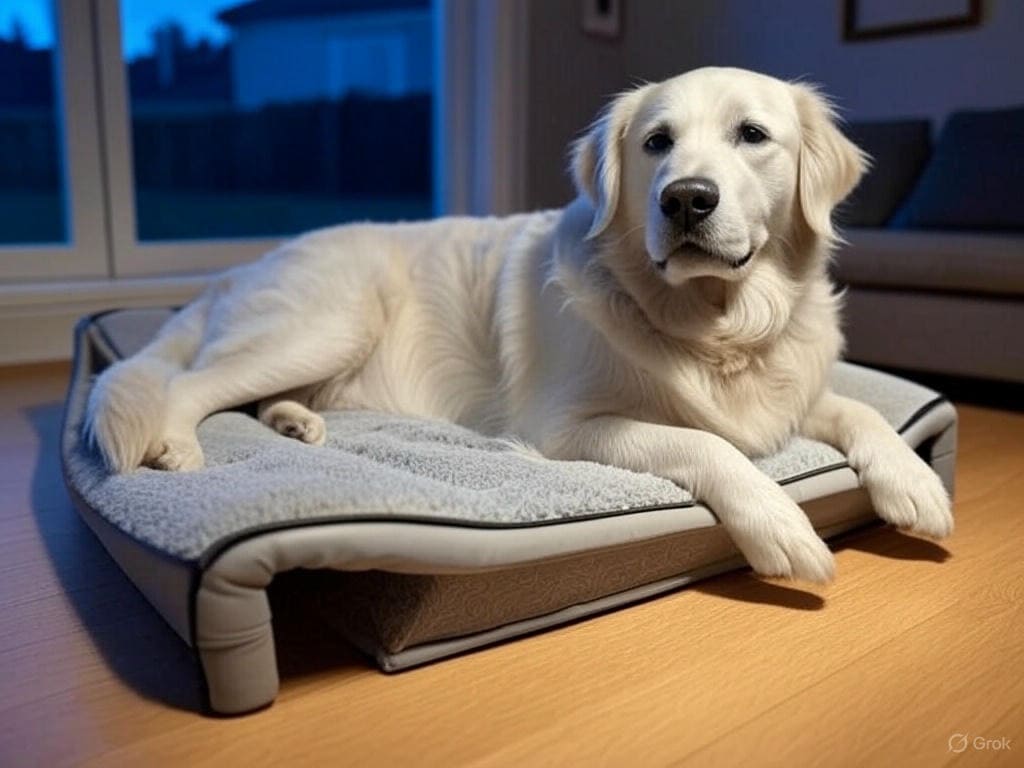Help your senior dog live a more comfortable and happy life by adapting their daily care to the needs of arthritis.
Learn how to adjust the daily care routine for senior dogs with arthritis, including tips on exercise, home environment, diet, and emotional well-being.
Understanding Arthritis in Senior Dogs
As dogs grow older, they often face health challenges, with arthritis being one of the most common. This inflammatory condition affects the joints, causing pain, stiffness, and limited mobility. In senior dogs, arthritis can significantly reduce quality of life, making routine activities like walking, playing, or even resting uncomfortable.
To ensure your dog’s well-being, it’s essential to adapt their care routine to meet the evolving needs that come with arthritis. Small changes in exercise, diet, and the home environment can make a major difference, helping your dog live more comfortably and safely.
This guide offers practical tips to help dog owners support their senior pets living with arthritis—covering everything from home adjustments to gentle activities and veterinary care.
Recognize the Specific Needs of Your Senior Dog
Senior dogs with arthritis often show signs of pain and discomfort. These may include reluctance to stand up, difficulty climbing stairs, slow walking, and stiffness, especially after rest. Behavioral changes such as less interest in play or a hunched posture may also occur.
Understanding these signs is the first step toward creating a care routine that respects their limitations. For instance, instead of long walks, shorter and more frequent outings can help maintain movement without overstraining joints. At home, keep essentials within easy reach to reduce unnecessary effort.
Each dog is unique. Observing your dog’s behavior and responses helps tailor the care routine to their individual comfort and quality of life.
Gentle and Consistent Exercise
Maintaining a light and adapted exercise routine is vital for dogs with arthritis. Gentle activities help strengthen supporting muscles, improve circulation, and reduce joint stiffness—contributing to better mobility and overall comfort.
Ideal activities include short, frequent walks on flat, soft surfaces like grass. Let your dog set the pace and watch for signs of fatigue. Supervised swimming is also highly beneficial, offering a low-impact workout that eases joint pressure while providing full-body movement.
Start slowly and gradually increase the frequency or duration of activity as your dog adapts. Include breaks to prevent overexertion. With care and consistency, your senior dog can enjoy the benefits of movement without discomfort.
Home Environment Adjustments
A safe and comfortable environment can significantly improve your senior dog’s day-to-day life. Orthopedic beds provide joint support and reduce pressure, offering relief and better rest. Place these beds in quiet, accessible areas where your dog feels secure.
Use rugs or runners on slippery surfaces such as tile or hardwood to prevent slips and falls. These additions help your dog move confidently through hallways and common areas.
Ramps are another excellent aid, allowing your dog to reach sofas, beds, or even car seats without painful jumps. These small changes create a safer, more comfortable home that supports your dog’s mobility and independence.
Proper Nutrition and Joint Supplements
A balanced, nutrient-rich diet is key for the health of senior dogs, especially those with arthritis. As metabolism slows with age, dietary needs shift to support joint health and maintain a healthy weight.
In addition to a well-rounded diet, specific supplements can be highly beneficial. Omega-3 fatty acids have anti-inflammatory properties that help reduce joint pain. Glucosamine and chondroitin are also recommended for cartilage repair and mobility support.
Always consult your veterinarian before introducing new supplements. They can recommend the most suitable options based on your dog’s specific condition and needs.
Regular Massage and Stretching Sessions
Incorporating massage and gentle stretching into your senior dog’s routine can ease muscle tension and boost comfort. Massage helps improve circulation and reduces joint stiffness, while also strengthening your bond with your pet.
Stretching increases flexibility and improves range of motion. Simple movements, such as gently extending the front and back legs, can relieve stiffness and enhance mobility.
Schedule these sessions during calm moments, such as after a walk or before bedtime. Observe your dog’s reactions and adjust the intensity as needed. Over time, your dog may look forward to these relaxing, healing interactions.
Veterinary Monitoring and Physical Therapy
Regular vet visits are essential for managing arthritis in senior dogs. Ongoing monitoring helps detect changes in joint health and ensures that treatment plans remain effective over time.
Physical therapy is a powerful tool that includes specialized techniques to relieve pain, improve mobility, and strengthen muscles. Depending on your dog’s needs, sessions may include guided exercises, stretching, or hydrotherapy—all designed to support movement without straining the joints.
Follow your vet’s guidance for exercise frequency, medications, and supplementation. Professional support plays a crucial role in helping your dog live with less pain and more vitality.
Emotional Comfort and Mental Well-Being
Supporting your dog’s emotional health is just as important as managing physical symptoms. Keep your dog mentally engaged with low-effort toys and interactive activities that encourage focus and calmness.
Show affection and maintain daily companionship. Your presence, attention, and comforting voice can significantly reduce stress and promote a sense of security and happiness.
Choose playtime activities that match your dog’s physical ability—such as slow-paced fetch games in a controlled environment. These moments help maintain emotional balance and strengthen the connection between you and your dog.
Conclusion
Caring for a senior dog with arthritis requires thoughtful adjustments to ensure comfort and improve quality of life. From tailored exercise and environmental modifications to proper nutrition and emotional support, every step makes a difference.
Pay close attention to your dog’s physical and emotional signals. Even small changes can offer big improvements in stability, safety, and happiness.
Veterinary guidance and, when appropriate, physical therapy are essential for ongoing support. With love, attention, and the right care strategies, your senior dog can enjoy a full and comfortable life—even with arthritis.

